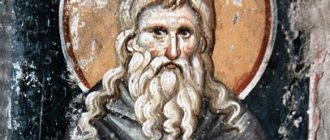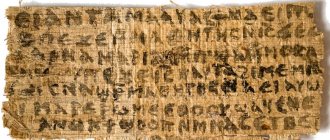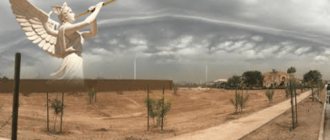What is "Apocalypse"? History and meaning of the term
This is the last book of the Bible and the only prophetic book of the New Testament; it was written, according to Church Tradition, by one of the twelve apostles - John the Theologian.
Most of the Apocalypse tells about the finale of the earthly history of mankind, therefore in modern consciousness this word is usually associated with something terrible and catastrophic.
How does the Bible interpret “the end of the world”? According to Christian ideas, the “Last Judgment” is the final moment of world history, preceding the renewal of the world and the final reunification of man with God.
In New Testament texts, references to the Last Judgment are most often allegorical in nature - the separation of the lambs from the goats (Matt. XXV, 31-33), the parable of the rational and foolish virgins (Matt. XXV, 1-13), etc.; but, of course, the most detailed description of the coming Last Judgment is contained in Revelation.
Who was John the Evangelist?
The Apostle John was one of Christ's closest disciples. The fact that the text of “Revelation” belongs specifically to John the Theologian is confirmed by the testimonies of his disciples and is recognized by the Church. Church Tradition connects with his name the creation of a number of canonical texts of the New Testament: in addition to Revelation, this is the fourth Gospel (from John), as well as the Epistles.
When and where was Revelation written?
There is debate about the time of writing of the Apocalypse, but it is believed that the work was created no later than the beginning of the 2nd century. The place where the Apocalypse was written is considered to be the island of Patmos, mentioned by John the Theologian himself as the place where he received revelations. Patmos is located in the Aegean Sea, south of the city of Ephesus.
Interpretations
Over the past 20 centuries, many different interpretations of the Apocalypse have appeared. They are usually divided into four groups. The first relate the prophecies of the Apostle John the Theologian to the “end times”, the second coming of Christ and the Last Judgment. Others view Revelation in terms of historical events, such as the persecution of Christians in 1st Vienna AD. Still others look for signs of apocalyptic predictions in modern history. Still others interpret Revelations as a source not so much of prophecies as of moral allegories.
At the same time, we must remember that nowhere in the Bible is there any indication of the exact day of the Last Judgment: “But about that day and hour no one knows, not even the angels of heaven, but only My Father,” says the Gospel (Matt. 24: 36).
Features of the presentation:
— Timelessness and merging of historical eras: spiritually related events, separated from one another by many centuries and even millennia, merge into one prophetic picture; the author of the Apocalypse describes some future events as past, and past ones as present: after all, the apostle is not talking about the chronological sequence of events.
— Symbolism: symbols and allegories enable the author of the Apocalypse to speak about the essence of world events through generalization. So, for example, eyes symbolize knowledge (knowledge), many eyes - perfect knowledge (omniscience). Horn is a symbol of power and might. Long clothing signifies priesthood; crown - royal dignity; whiteness - purity, innocence; the city of Jerusalem, the temple and Israel symbolize the Church.
— Numbers also have a symbolic meaning: three symbolizes the Trinity, four symbolizes peace and world order; twelve - the people of God, the fullness of the Church (numbers derived from 12, like 24 and 144,000, have the same meaning). Great importance is attached to the number seven (seven seals; compositionally the book is divided into seven parts).
Images from "Revelation"
Lamb is the symbolic name of Jesus Christ, who sacrificed himself for the salvation of man.
The Book of Life is, according to Christian tradition, a book in which the names of the righteous are written. It is sealed with 7 seals , which can only be opened by the Lamb of God before the Last Judgment.
The Four Horsemen of the Apocalypse are characters from the sixth chapter of Revelation. They appear one after another, each with the opening of another of the first four seals of the Book of Life (there are 7 seals in total, as already mentioned).
The first to appear is a rider on a white horse, he symbolizes the birth of man, has a bow and a crown and is called “victorious” by John. The second to appear is a red horse, on it is a rider with a sword; in the text it is believed that it symbolizes a war of extermination. The third rider on a black horse holds scales in his hands and symbolizes balanced maturity. The fourth horseman is on a white horse, “whose name is death.”
The 7 angels of the Apocalypse and 7 trumpets symbolize the end of times and the judgment of God: “And the seven Angels, having seven trumpets, prepared to sound.” In ancient times, the sound of a trumpet (horn) was used to warn of danger, give signals in battle, or announce important events.
“The Last Judgment” is one of the most important themes in world art. One way or another, it was touched upon by most of the great artists, including Michelangelo, El Greco, Albrecht Durer, Nicholas Roerich and others.
The authors, of course, brought their personal vision to the works, interpreting the images of the Angels of the Apocalypse, Horsemen (Warriors) and the Day of Judgment itself. But looking at these works, one can imagine how the Apocalypse will develop in its Christian “scenario”.
Liturgical use
One of the reasons for the paucity of early texts may be the fact that reading from the book of Revelation was never part of the liturgical practice of the Eastern Church, perhaps because the composition of the service was formed before the book was finally included in the canon of the New Testament (and at present, the book of Revelation is not read during services in the Orthodox Church, with the only exception mentioned below). Therefore, in particular, passages from Revelation are absent from the Greek lectionaries (liturgical books containing passages of Holy Scripture read during worship), which are one of the important manuscript sources[10].
At the same time, the second chapter of the current Typikon (Jerusalem Charter) prescribes the reading of the Apocalypse during Great Lent at the “Great Reading” as part of all-night vigils (between Vespers and Matins) [11], which was absent in the Studian (due to the absence of vigils as such in it) and the Evergetian Charter [12].
In the Catholic Church it is currently recited at Sunday Masses during the Easter period (in liturgical year C), and songs from it are also included in the “Liturgy of the Hours.”
In the Lutheran Church, readings from the book of Revelation are found quite often in the liturgical calendar: First Sunday of Advent (Circle C), Sunday after the Nativity of Christ (B, C), third Sunday of Lent (B), tenth Sunday after Trinity (A), penultimate Sunday church year (C), New Year, Circumcision and naming of Jesus (C), Annunciation (C), Transfiguration (C), Archangel Michael's day (A), All Saints' Day (A, C).
Capabilities
Apocalypse is an ancient mutant born with various superhuman abilities, which are further enhanced after merging with Celestial technology. The character has complete control over the molecules of his body, allowing him to change his shape as he pleases, for example, he can become extremely plastic and flexible or change his size, increase his physical abilities, transform his limbs into weapons, wings, or jet engines, heal from fatal injuries, adapt your body to any disease or hostile environment, and endow yourself with virtually any superhuman strength. He is also able to project and absorb energy, in addition to reflecting telepathy and telekinesis. Apocalypse is also capable of Technopathy (the ability to communicate with machines), being able to directly interact with the various technologies he has at his disposal. With the help of his mutant powers, Apocalypse made himself immortal.
Plan of revelation
Let's consider what parts the Apocalypse of John consists of, what order the end of the world will have:
- an introduction in which God tells the apostle to write down a prophecy;
- 7 letters intended for seven churches;
- a vision of God, the Lamb, and worship in heaven;
- the opening of seven seals by Jesus Christ, which serves as a signal for the start of war. These are the so-called harbingers of the Apocalypse (four horsemen);
- seven angels blow trumpets, announcing the beginning of disasters on earth. Believers receive a seal on their forehead, which will protect them;
- seven signs of how humanity will be divided into two camps at war with each other. Conscious universal evil appears in the form of a dragon, two witnesses of Christ fighting him;
- the appearance of the seven bowls (Armageddon) and the beginning of the Great Judgment;
- a description of the judgment of evil, the death of the false prophet and the Antichrist;
- the result of the war: the punishment of all guilty people and spirits, the triumph of the forces of good;
- description of the new world - heaven and earth after the apocalypse.
In culture
- A series of tapestries with scenes from the “Revelation” “Angers Apocalypse” (XIV century) in the city of Angers, France.
- 15 woodcut engravings by Albrecht Dürer for the publication of “Revelation” by Koberger (1498), which brought European fame to the German artist due to the general fear of the end of the world in 1500.
- A cycle of 28 engravings with scenes from the Revelation, made by Jean Duve (1546-1555).
- “A short story about the Antichrist” by Vl. Solovyov (1900).
- Boris Savinkov published the story “The Pale Horse” (1909), and Elem Klimov gave the title to the film “Come and See” (1985), borrowing lines from chapter 6 verses 7-8 of “Revelation”: And when He opened the fourth seal, I heard a voice the fourth animal, saying: “Come and see.”
And I looked, and behold, a pale horse, and on it a rider whose name was “death . - The British film series The Omen (1976–2006) is based on the plot of Revelation.
- In the television series “Supernatural” (USA, 2005), the 3rd, 4th and 5th seasons are devoted to the theme of the Apocalypse.
- In the television series Dexter, the main antagonist of Season 6 imitated scenes from Revelation.
- The novel by Arkady and Boris Strugatsky, “Burdened with Evil, or Forty Years Later,” gives an original interpretation of the personality of John and the events on the island of Patmos that led to the writing of “Revelation.”
- Full-length feature film “Apocalypse: The Revelation of John the Evangelist”
Society Associations
As a rule, many people associate the word “apocalypse” with something terrible and terrible. This is what they call the end of the world, when terrible disasters occur, people die, and the Earth’s lithosphere is destroyed. There are many films in which the apocalypse is the last day of the planet’s existence. Huge meteorites rain down on it, hot lava from volcanoes spills onto cities, and tornadoes and tornadoes sweep away everything in their path. But where could such associations come from?
Life of John the Evangelist
According to the Gospel of Matthew, John the Evangelist, son of Zebedee, together with his brother James, left their family and became a disciple of Jesus Christ.
From that moment on, he was not separated from the teacher and witnessed numerous miracles performed by him. It was John who took care of the Virgin Mary, like a devoted son, after the execution of Jesus Christ. When the Dormition of the Most Holy Theotokos took place, the apostle, together with his disciple Prokhor, left Jerusalem to preach Christianity in distant lands and islands.
John the Theologian
On the way, they had to endure many trials: a shipwreck, persecution by the authorities, hunger, cold and disbelief in his words. He was captured and tortured, but the Lord performed a miracle, and John the Theologian remained unharmed.
Then, by decision of the authorities, he was exiled to a remote island called Patmos. It was there that he heard and wrote down the Revelation. During his long life, the holy apostle performed many miracles. He was the only one who lived more than a hundred years and outlived all the other disciples of Christ.
Artists usually depict the holy apostle as a man of advanced years, in red clothes with an inkwell, a book and a pen.
Often there is an eagle nearby, a symbol of the high flight of his thoughts, or an angel. There are also images of John at a young age.
Omens
So what events will indicate the imminent arrival of the end of the world? Matthew 24 tells us that when Jesus' disciples wanted to show him the temple building, he said that it would soon be destroyed.
Of course, they began to inquire about the exact date of the event. It was at this moment that Jesus began to talk about when the end of the world (Apocalypse) would come. First of all, he said that there would be a huge number of charlatans who would pretend to be the Savior. In addition, wars, pestilences, earthquakes will begin, and people will be punished and killed for their righteous faith. The second coming of Christ will be similar to those days when there was a universal flood and only Noah and everyone who was in his ark survived. The interesting thing is that no one knows the exact date when this will happen except God. In addition, the Bible says that after the Apocalypse there will be a Day of Judgment.
Notes
- Metropolitan Hilarion about the Apocalypse in the television program “Church and the World” (unspecified)
(inaccessible link). Access date: June 7, 2010. Archived October 13, 2012. - Lopukhin's Explanatory Bible
- ↑ 1234
Orthodox Encyclopedia, 2010, Dating. - A. Men in the book “Reading the Apocalypse” by Fr.
- D. Guthrie in the book “Introduction to the New Testament Archival copy dated January 1, 2008 on the Wayback Machine” examines in detail the arguments of both supporters and opponents of the authorship of John the Theologian
- Church history. Book 3, ch. 39, 5.
- Robert H. Mounce. The Book of Revelation, pg. 15-16. Cambridge: Eerdman's
- CANON - Local Council - Laodicean
- Local Council - Carthage
- Bruce M. Metzger. Textuality of the New Testament. Moscow, 1996. pp. 30-35.
- Typikon, in other words, a depiction of the church following in Jerusalem the Holy Lavra of our reverend and God-bearing father Sava
- V. P. Vinogradov. Statutory readings (preaching of the book). Sergiev Posad, 1914
- E. D. Frolov and others. Christianity: antiquity, Byzantium, Ancient Rus'. L., 1988. litmir.info/br/?b=198986&p=6










